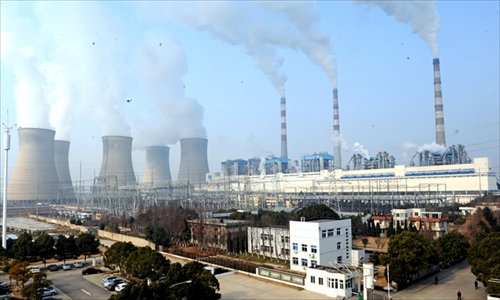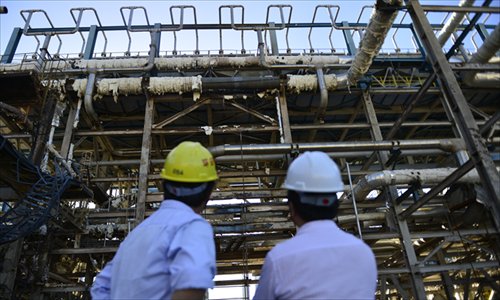Public outrage derailing China’s growing number of needed plants

A coal-fired power plant in Huainan, Anhui Province runs at full capacity on January 5 to ensure the power supply to the Yangtze River Delta, including Shanghai. Photo: CFP

Technicians inspect the site of an explosion at a controversial chemical plant in Zhangzhou, Fujian Province on July 30. Photo: CFP
The day before the bad news suddenly came on July 13, Deng Weidong was busy preparing further material outlining the nuclear project for the public. But he was then told the flagship 37 billion yuan ($6 billion) nuclear fuel project in Heshan, Guangdong Province was to be suspended.
This was only a few days after the project published a notice seeking public opinions on July 4. The 44-year-old director of the local development and reform bureau was totally unprepared for this strike, despite large-scale protests having been seen before.
Every Heshan official was taken aback by the news. The project had been the largest focus of the entire city government for the past seven months. Deng said such high expectations had been placed on it that its suspension was a body blow to morale.
This bad news has not come alone for large-scale government projects. Just a few weeks later, Shenzhen announced on August 8 that a major coal-fired power plant which had been planned for years was to be abandoned after encountering resistance from the public and local People's Congress's delegates.
What happened in Shenzhen and Heshan were not stand-alone cases but reflect the fact that more and more such plans are facing repeated failure nationwide after protests.
In May, a 19-billion-yuan petrochemical project in Kunming, Yunnan Province, met with waves of discontent from local residents, which still have not been dispelled. In April, a project that planned to build the largest power battery manufacturing base in East China near Shanghai was also abruptly cancelled due to strong opposition.
As Chinese economic reform and social development progressed down the decades, these flagship projects were often meant to be boosters for local economies. But these projects are increasingly at odds with reality, as the public are more concerned with their living environment, along with a growing awareness of civil rights.
For a country that is on the fast track of industrialization, such big projects are often badly needed in certain production chains. Some are worried that if the protest-and-abort trend continues, the country will not be able to build such large-scale projects in the future.
Big troubles for big projects
Deng was transferred to a Party chief post in a local town in Heshan after the project died. Although Deng told the Global Times he was not allowed to accept interviews due to orders from above, the disappointment in his tone was clearly palpable.
As a major government official who had participated in the project, Deng witnessed the entire process from securing the project after intense competition from some 40 cities to its premature end.
As early as March, when the Heshan government signed the investment framework agreement with China National Nuclear Corporation (CNNC), the project was described as being ambitious. It sought to build an integrated industrial chain of nuclear fuel processing, including uranium purification and enrichment as well as the manufacturing of nuclear fuel components.
According to the Heshan government's estimate, the plant could have generated 10 million yuan of profit a day, while its annual industrial added-value could have reached more than 8 billion yuan.
However, after more than six months of hard work, when the project entered the public opinion consultation stage, it met a large scale of protests and demonstrations from local residents.
Worse pressure also came from neighboring cities like Guangzhou or Foshan that expressed grave concerns at the plans, with even the governments of Macao and Hong Kong joining in the chorus of complains.
Although the plug was pulled on July 13, the government had already invested 144 million yuan for land acquisition from local farmers but now this land has no immediate use.
The protest scenes reminded people of what happened in Kunming two months ago, where a major project was also to have a big impact on local economic development.
Opposition voices in Yunnan thought the petrochemical plant, especially including its subsidiary PX project, would produce a large amount of pollutants, which could cause irreversible destruction to a city reputed for its environment and greenery. The message they delivered was clear: Such a project should not be built near Kunming.
In order to dispel such public discontent, city officials went into a PR overdrive. News conferences, public meetings, a new Weibo account for the city's mayor, all these steps were taken to assuage public doubts.
However, questions remained, doubts did not fade and the fate of the plant was sealed.
Still need to build
However, most experts, scholars and even non-governmental organizations agree that China's economic growth will continue to require such large-scale industrial facilities. The real question is how to get them built.
Dai Xinyi, a professor from the environmental science and engineering department of Fudan University, thinks that these projects can be divided into two categories: large infrastructure projects paid by public finances and large commercial and industrial projects invested in by private interests.
For the former type of project, efficiency is an issue that needs to be considered so as to prevent haphazard investment and redundant construction. "For example, is it necessary to build so many ports along the Yangtze River Delta? And the analysis of whether to build airports and highways in remote western regions should be different from that in eastern coastal regions," Dai told the Global Times.
For large-scale commercial and industrial projects, Dai said the precondition is that there must be a local demand for such projects prior to their inception. "At present, over 90 percent of the domestic manufacturing industry are at overcapacity, so we should ask if it is truly necessary to build more steel plants and the like?"
But in some other cases, such as PX projects which have stirred up strong public feelings, the country is now facing a serious capacity shortage of PX products due to the repeated public blocking of plants. This had led to downstream industries becoming highly dependent on imported PX raw materials from other countries.
According to Chinese customs data, China imported 3 million tons of raw PX materials from January to April 2013, a 53.5 percent year-on-year increase, with the main source of imports being neighboring Japan and South Korea.
In fact, with the intensified opposition toward PX projects in China, the industry has fallen into a dilemma as its development is stagnating while demand is continually growing.
"PX projects are really not as terrible as the public believes. The risks can be minimized by strengthening production management, ensuring strict pollution controls and making contingency plans. PX plants also have a significant meaning for China's energy security and strategy," Dai said.
"If such projects are necessary but fail to develop healthily, all of society will feel the losses, not just the government or enterprises. For example, if the nuclear industry, which I think is necessary for China's economic development, is not allowed to develop, we will have to burn more coal which will be worse for the environment," he said.
Losing credibility
Although Dai does not think the Chinese government would stop the construction of large plants, these failures have jeopardized the credibility of local governments, a critical issue if they want to continue to promote large projects in the future.
"The series of suspended projects exposed a deeper problem, which is the collapse of credibility of our governments. Officials need to ask themselves why in some matters, such as earthquake relief, the people trust them, but on industrial projects, what they say is dismissed," Dai said.
Zou Ji, associate dean of the Environmental School at the Renmin University of China also believes that China cannot progress without these industrial pillars.
"China's industrialization is not complete, market demand will remain high for a long time, so the planning, construction and operation of these projects must be above reproach," he said.
"For some 'sensitive projects' where people recognize the necessity but refuse to have them built near them such as nuclear facilities, waste disposal facilities or chemical plants, the solution is to make sufficient planning in advance. These projects should be isolated from sensitive population bases so that they can avoid being scrapped," Zou concluded.
Voices from civil organizations also believe that China's economic development requires the support of large projects. However, the current planning of these often lacks timely full disclosure of information or social impact assessments, which are large reasons for the continued public backlashes.
"Over the past two decades of China's economic development, people have seen a wealth of accomplishments. However, more and more problems are emerging because of incomplete participation during the decision-making process. For example, more and more cancer villages are being found, so people have become aware that development can be detrimental to their health and their environment," Li Bo, an executive for environmental NGO Friends of Nature, told the Global Times.
"When enterprises chase profit and local governments only care about GDP figures, people will stand in their path. You can't keep the old way of only talking about income without considering environmental costs into account," Li said.
"In fact, if authorities really valued public opinions, they would find a wealth of helpful comments and guidance from the public," Li said.